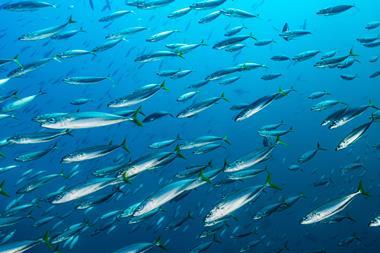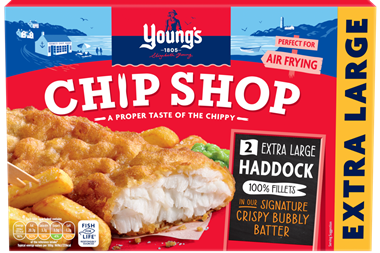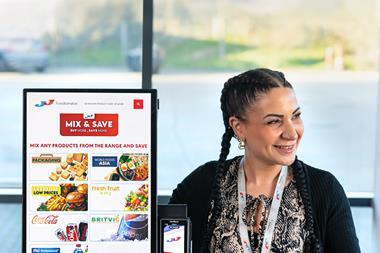the new poultry? Kit Davies reports
Fresh salmon is no longer a seasonal luxury it's available 52 weeks a year at about half the price it was a decade ago. Indeed, it seems to be cropping up everywhere these days, piled up in heaps where once the chicken drumstick reigned supreme.
Against the context of doom and gloom about the level of cod and haddock stocks in the seas, and the rising popularity of fish generally, its production stronghold in the burgeoning global farmed sector means it is rapidly on the road to becoming a big hitter among the proteins.
Salmon as the new chicken, perhaps? Well no, with salmon at only a fraction of poultry's 1.72 million tonnes.
But look at the data. Scottish aquaculture produced just under 10,000 tonnes in 1986, nearing 130,000 tonnes in 2000. Overall supply to the UK rocketed from 28,569 tonnes in 1991 to 93,468 tonnes in 2000.
The value of chilled salmon in all formats for in-home consumption leapt from £108m in 1997 to £188m in 2001.
Meanwhile global aquaculture, being driven by multinationals such as Cermaq, is developing rapidly outside Scotland with Chile set to overtake big hitter Norway as the world market leader in farmed salmon production.
"Take wet smoked fish and shellfish this is fish that is either smoked, coated, natural or shellfish, and salmon is the leading species," says Gillian Kidney at Taylor Nelson Sofres. "Here you have growth of 25.3% in the year to December 2001. Category growth is just 14%.
"Smoked salmon is the fourth largest specie, growing at a similar level to salmon at 24.8%, with sales at £58.1m."
"Our third category, defined chilled fish, is in essence added value fish, so that's ready meals and products such as salmon encroute. Even that's growing 11.8% year-on-year, and accounts for 31% of sales at £50.7m."
A definitive study of the potentiality of British fish sales was carried out by the Irish last year in preparation for their first major seafood exposition in Dublin.
They noted: "Salmon is gaining in popularity as consumers search for alternatives to meat and poultry and is set to increase by 10% annually...it represents a major opportunity, driven by the increasing consumer use of portions and salmon ready meals." The Irish Sea Fisheries Board recommends its exporters to the UK should prioritise salmon portioned fillets and steaks, and salmon convenience meal products.
But a message about the sheer versatility of salmon must get across, the report stressed. There is a lack of understanding among consumers about how to prepare and cook fish. "It is still difficult to get UK consumers to try new fish species promotion and education are therefore important in growing sales of new fish species."
If you compare what you can do with the two proteins, it emerges as a case of anything you can do, I can do better. Salmon as a steak is an upmarket affair while chicken breast now seems less so than in the past; and salmon is just as flexible in terms of sauces or coatings, ethnic or otherwise. Salmon can be cooked in all the ways that chicken can but can also be deep fried, turned into pâté, poached, steamed and covered in pastry. It can be eaten raw. It is fully suitable for the barbecue.
Another key factor in the rising popularity of salmon will be how expensive it remains compared to poultry.
In Sainsbury, you can buy a medium sized chicken for well under £4. But checking the salmon in the same store in Crawley, a typical pack of two salmon portions was priced at £3.99. So that is about half the amount of food in meal terms for the £4 ticket. Yet the same Sainsbury in Crawley has also had a significant number of substantial price cut offers on salmon packs, such as a 720g pack for the price of a 480g pack (50% extra free) at £5.99.
And the concept of economy salmon has emerged with Tesco offering Value smoked salmon trimmings at a mere £1.49 (150g).
Yet salmon could well find that a premium positioning does nothing to harm its volume growth in the long run.
Meanwhile, poultry sector suppliers have been known privately to express fears that their market has reached saturation point. They worry about how much more growth can be generated from a mature sector.
Chicken presents a track record of strong growth at the expense of its red meat competitors that salmon could well emulate in the coming decade if it keeps on its current roll. Poultry after all accounted for only a fifth of overall meat volume 20 years ago and now stands at 40%.
Leading branded fish supplier Young's certainly sees the emulating of chicken as the way forward to tap a great potential and has come up with the buzzword Chickenability'. Chilled marketing controller Mark Ventress thinks processors still have lessons to learn from the poultry sector in terms of making salmon easy to use. "It is a question of making it clear to consumers precisely what they do with it. The Chicken Tonight lesson if you like. Microwaving is important because it microwaves so easily without loss of quality. Education really is key, because there still is this barrier to salmon that puts people off. We have a huge amount that we can do as an industry.
"Salmon has an aspirational quality, it has a very good caché as a premium but affordable food. It really has a very good perception among consumers and I am confident we will see it continuing strong growth."
Young's commercial director Jim Cane adds: "It was held back by the lack of an intelligent development approach. Until we began redevelopment of the sector over a year ago no manufacturer had been willing to invest the money or energy into it to overcome the barriers."
And that aspirational quality can only be boosted by the development of organic farmed salmon. Aquascot, which farms and markets 95% of Europe's organic salmon and supplies Sainsbury with a chic offering, says demand is exceeding supply in most markets.
Such developments help the Scottish industry fight back against the attacks on farmed salmon practices by environmentalists, though Young's Ventress feels there is no evidence of consumers being deterred to date by the various media onslaughts.
Brian Simpson, chief executive of Scottish Quality Salmon, points to the processing sector increasingly developing new and innovative salmon dishes in a move to meet growing consumer demand. "As supplies of white fish become ever scarcer, salmon is the ideal choice for those processors who traditionally worked with white fish. This is an important move, not just for consumer and retailer demand, but also for jobs and businesses in many parts of the Scottish and Humberside processing industry," says Simpson. "The major consideration for marketing is the change to labelling legislation we see that as a huge opportunity to promote Scottish quality salmon on a level playing field against imports."
Scottish Quality Salmon naturally looks to inspire patriotic feelings, and didn't take kindly to a survey which showed some consumers thought what they were eating had come from Norway when it was Scottish product.
Kelly Colrein, trade marketing manager at leading own label supplier Marr Foods, agrees salmon is no longer seen as a luxury product but a tasty, healthy alternative to other proteins. "The majority of added value meals made with fish are made with salmon which shows the consumer is prepared to select salmon as a main protein option.
"There is no doubt that manufacturers and retailers are fully aware of the rising popularity in salmon and are taking advantage of this. Salmon has always been popular and now lower prices, with regular price promotions, mean it is acccessible to everyone. Regular price promotions are also benefiting the consumer while also ensuring they stay loyal to the sector."
Marr Foods has worked to develop a system of sustainable fishing for Wild Alaskan Pink Salmon, and was the first company to be awarded an on-pack accreditation from the Marine Stewardship Council a powerful marketing tool to sell to environmentally conscious consumers.
But it is important not to forget that there are other growing success stories in fish, not least in exotics as consumers turn adventurous. Michele Taylor, Sainsbury manager for fresh fish, cautions: "In the last year there has been larger growth across more exotic species such as swordfish, tuna and marlin as well as more consumer friendly' products such as cod loin and skinless/boneless products, over fresh and smoked salmon."
Young's, meanwhile, has in place a vigorous "revolution" to drive what it sums up as "the latent promise of this superbly flexible protein" with the heralded growth drivers convenience, ethics, better for you and kids' with the latter it is eyeing the potential for alternatives to fish fingers. So just think, if salmon cracks the fast food market, chicken could really be on the run. n
{{FEATURES }}
Close menu
- Home
- Retail & Wholesale
-
Products & Suppliers
- Back to parent navigation item
- Products & Suppliers
-
Product Categories:
- Back to parent navigation item
- Product Categories:
- Alcoholic drinks
- Bakery
- Cereals & breakfast
- Cheese
- Chicken & poultry
- Chocolate
- Confectionery
- Crisps, nuts & snacks
- Dairy
- Fish
- Fresh produce
- Frozen
- Household
- Meat
- Own Label
- Sauces & condiments
- Seasonal
- Soft drinks
- Vaping
- Vegan & plant-based
- World foods
- Suppliers
- People
- Reports & Data
-
Topics A-Z
- Back to parent navigation item
- Topics A-Z
-
Popular topics:
- Back to parent navigation item
- Popular topics:
- Cost of living crisis
- Crime
- Deposit Return Schemes
- Finance
- Government & Regulation
- Health
- Inflation
- Loyalty
- Marketing
- Mergers & Acquisitions
- New Product Development
- Sourcing
- Supply chain
- Sustainability & environment
- Technology
- Ultra Processed Foods
- Vaping
- A-Z all topics
- Content by type:
- Events
- Subscribe now
Sign in to comment on this article
Not logged in before? Register for FREE guest access today.
You will be able to:
- Read more stories
- Receive daily newsletters
- Comment on stories
Advert

















No comments yet